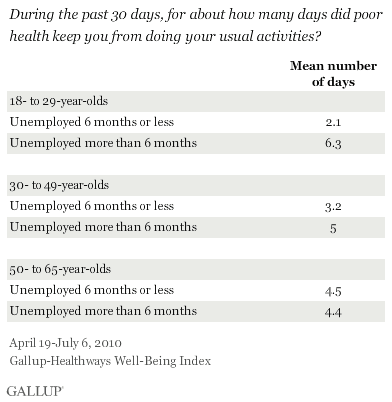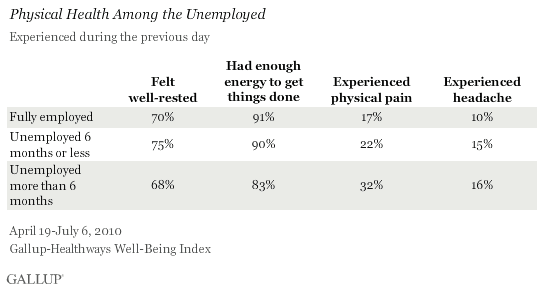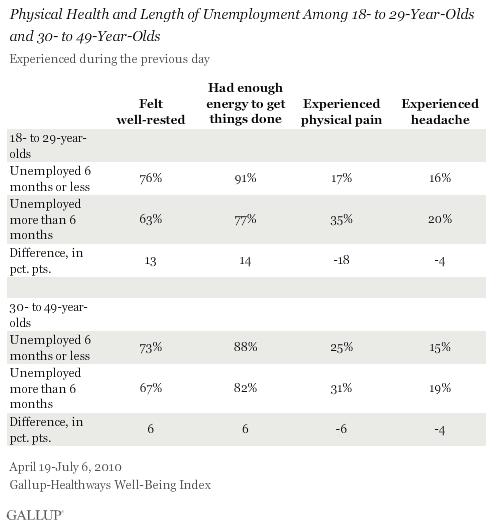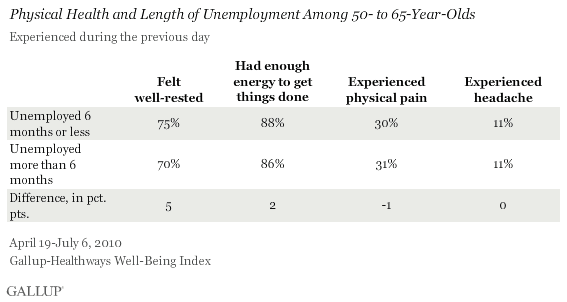WASHINGTON, D.C. -- Long-term unemployment seems to have a greater impact on the health of 18- to 29-year-olds than it does on adults aged 30 and older. Young adults who are out of work for more than six months have three times the number of poor health days as those unemployed for less time. The number of poor health days also increases with length of unemployment, but to a smaller degree, among unemployed Americans aged 30 to 49, but it does not increase among older Americans.

Compared with those out of work for six months or less, the long-term unemployed overall experience physical pain more often and are less likely to report feeling well-rested or having the energy they need. Those unemployed for any length of time report slightly more headaches than those fully employed.

The findings are from the data collected between April 19- July 6, 2010.
They reveal that negative daily experiences for the employed and unemployed differ by age, with the 18- to 29-year-old age group appearing to be hardest hit. Those experiencing physical pain doubles among 18- to 29-year-olds who have been unemployed more than six months compared with those unemployed for less time. Feelings of rest and energy also fall off sharply among this age group. Among 30- to 49-year-olds, smaller but significant differences also exist.

Interestingly, among unemployed Americans aged 50 to 65, there is little difference between length of unemployment and daily physical health.

Bottom Line
For younger Americans, long-term unemployment is related to less positive daily physical experiences, but the same is not true for Americans aged 50 to 65. It is important to note that respondents may have been experiencing health ailments prior to losing employment, making the direction of causality unclear. The existence of physical pain, greater sick days, and loss of energy may make it more difficult, at least for the younger unemployed, to maintain employment or find new job opportunities.
It is possible that older Americans have learned to manage conditions such as physical pain so that it doesn't influence employment. to handle the stress of long-term unemployment by supplementing lost income with the income of a spouse or savings and severance packages, leading to more positive daily physical experiences.
Regardless of the cause, these findings document a relationship between length of unemployment and daily physical health among two key cohorts of Americans' working -- and job-seeking -- population.
Learn more about the .
Survey Methods
Results are based on telephone interviews conducted as part of 优蜜传媒Daily tracking/the Gallup-Healthways Well-Being Index survey April 19-July 6, 2010, with a random sample of 3,772 unemployed adults, aged 18 and older, living in all 50 U.S. states and the District of Columbia, selected using random-digit-dial sampling.
For results based on the total sample of national adults, one can say with 95% confidence that the maximum margin of sampling error is 卤2 percentage points.
For results based on the total sample of each age group, one can say with 95% confidence that the maximum margin of sampling error is 卤4 percentage points for 18- to 29-year-olds, 卤3.4 percentage points for 30- to 49-year-olds, and 卤3.2 percentage points for 50- to 65-year-olds.
Interviews are conducted with respondents on landline telephones and cellular phones, with interviews conducted in Spanish for respondents who are primarily Spanish-speaking. Each daily sample includes a minimum quota of 150 cell phone respondents and 850 landline respondents, with additional minimum quotas among landline respondents for gender within region. Landline respondents are chosen at random within each household on the basis of which member had the most recent birthday.
Samples are weighted by gender, age, race, Hispanic ethnicity, education, region, adults in the household, cell phone-only status, cell phone-mostly status, and phone lines. Demographic weighting targets are based on the March 2009 Current Population Survey figures for the aged 18 and older non-institutionalized population living in U.S. telephone households. All reported margins of sampling error include the computed design effects for weighting and sample design.
In addition to sampling error, question wording and practical difficulties in conducting surveys can introduce error or bias into the findings of public opinion polls.
For more details on Gallup's polling methodology, visit .
About the Gallup-Healthways Well-Being Index
The Gallup-Healthways Well-Being Index measures the daily pulse of U.S. well-being and provides best-in-class solutions for a healthier world. To learn more, please visit .
